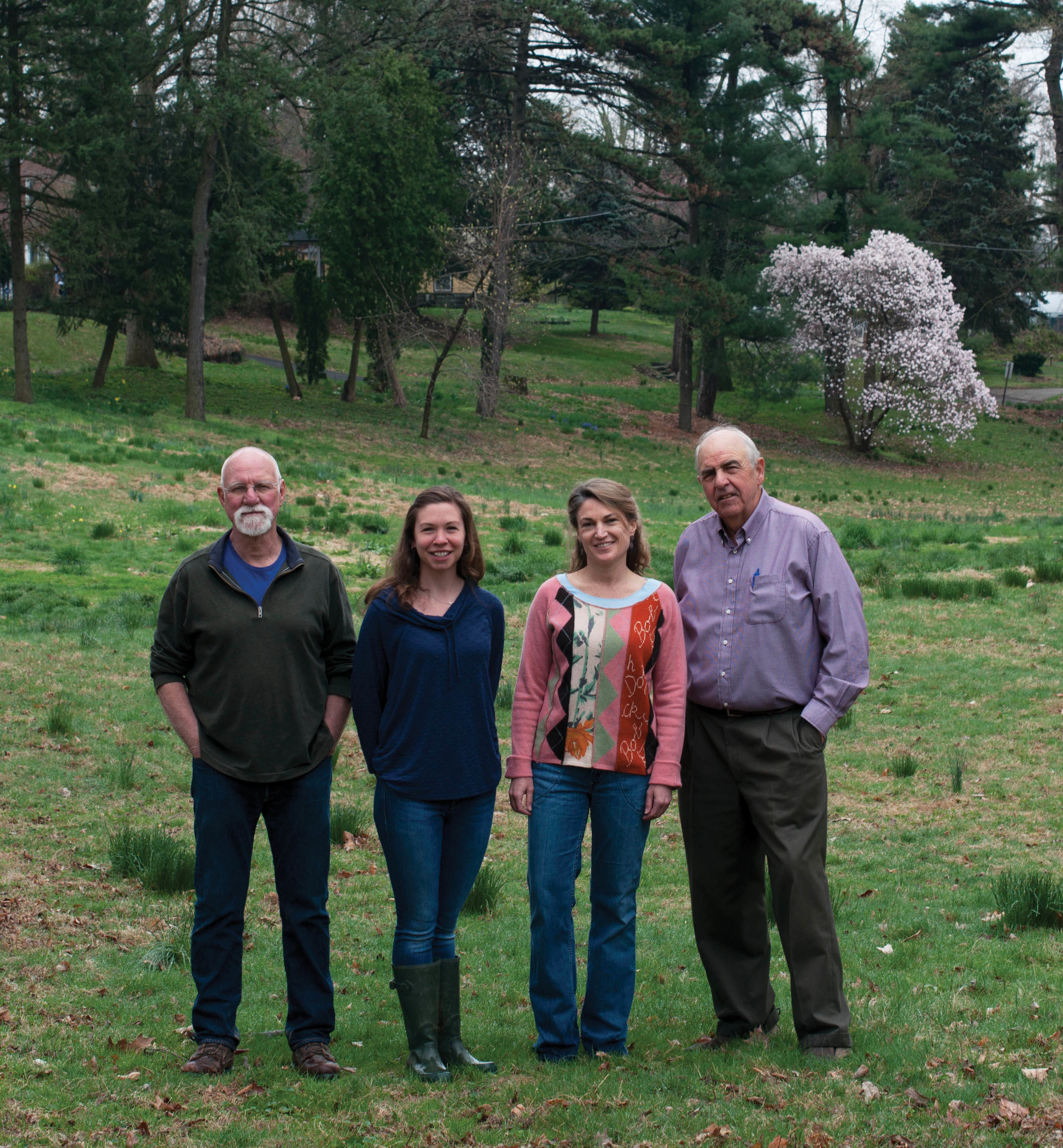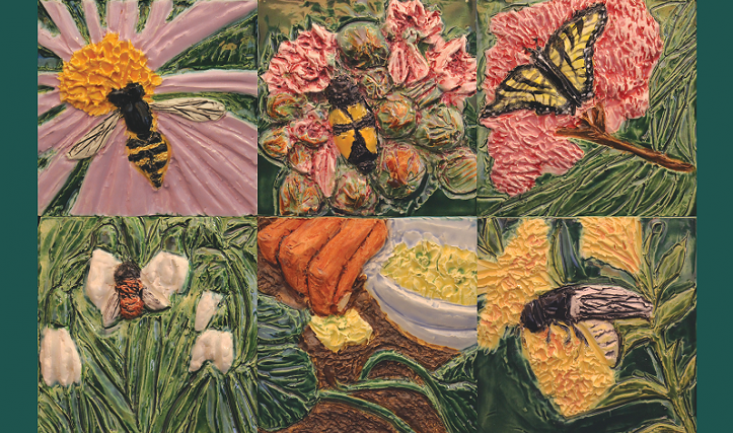Awbury Arboretum’s unlikely stewards let nature—and discovery—run wild
Awbury staff from left to right: Denis Lucey, Karen Flick, Heather Zimmerman and Chris van de Velde.Philadelphians are familiar with the sounds of city life: the laughter of kids walking home from school, bus engines and car horns on the busy streets, music flowing from rowhome windows. Amid the bustle in Germantown, a forest is quietly growing. The people entrusted with the 55-acre refuge at Awbury Arboretum believe that it’s a place to escape the hardscape, wonder at nature’s resilience and power, and maybe to fall in love.
Between a trickling creek bed on the grounds of Awbury Arboretum in Northwest Philadelphia and the abrasive honking of East Washington Lane, Denis Lucey is out on one of his many walks.
He stops to point out a mutated form of a snow drop flower and invites me to have a gnaw on a native spice bush. “It’s got an interesting flavor,” he encourages. “If you’ve ever been operated on, the orange dye they spray you with before they put the bandages on is a glue that originally comes from this plant.”
And before you can ask a question like, “Wait—did I just eat surgical glue?” he’s moved on to the next topic, spurred on by the arboretum’s diverse flora and his teaching instincts. Lucey takes to the environment, and it seems to take to him as well, as vines and roots tug on our pant legs throughout the amble. At one point a butterfly almost lands on his head.
Unlike other facilities of its kind in the area, Awbury doesn’t have much in the way of decorative plots or rose gardens; it’s simply a 55-acre patch of plant life, walled off with stone from an old barn, where nature is encouraged to punch through the surface of the earth and grow. Lucey possesses the ability to look past the damage to the natural world and see the splendor in its resilience.
“This part of the world always wants to be forest,” Lucey says. “It’s a wild place with a lot of notable big trees. Let’s go look at a couple of them.” Awbury is home to native life such as cherry trees, beeches and sycamores, as well as a pond, a natural spring, wetlands and a Weavers Way farm tract across the street. As Lucey begins our tour of the grounds he knows so well, it is hard to imagine the arboretum without him. When his replacement, Karen Flick, inherits his role in the coming weeks, she will be continuing the work of a horticulturalist praised by his peers, if underappreciated by outsiders. His work follows a simple mantra:
Let it grow.
It takes a village
Lucey will be 72 this year. He’s a former physician—he was talked out of a landscape architecture major before applying to medical school—who comes from a family of teachers, talkers and gardeners.
While working as a consultant on acquisitions and medical practices, an unusual opportunity presented itself. Lucey recalls, “A neighbor got into a dispute with his landscaper and liked some landscaping in my yard.”
So, Lucey was called into service and his natural horticultural skills attracted more clients until he was able to take on the work full-time. Eventually, word spread and he was approached about doing part-time work at Awbury Arboretum. He wasn’t sure about leaving his business, but, “I was falling in love with the place,” Lucey confesses. His background in both history and plants, in addition to working in development and consulting, made him perfect for an executive job, but he actually wound up doing a lot of hands-on work his first year. Lucey’s love for the grounds served as motivation to maintain a scattered schedule between his business and the demands of Awbury’s maintenence.
Lucey doesn’t hop over fences as vigorously as he would have five years ago, he says, due to some ligament damage in his leg. It’s tougher to get up from a kneeling position than it used to be, and he might also have a crack in one of his pinky bones. His 40 hours a week were eventually cut to 20, and further limitations have left him at only four, but even in such a small window he’s made an impact.
“Organizations can do well if they get good people to come do stuff,” says Awbury’s general manager, Chris van de Velde. “Denis is a very knowledgeable horticulturalist and gardener, but he has a passion for the history of Awbury and the heritage of plants. He’s got a good scheme on how to try and maintain this property, at less cost, using less environmentally-adverse impact techniques.”
Van de Velde himself fits his description as one of the good people out doing stuff. A former PGW executive, he has referred to his unpaid volunteer work at Awbury as his “failed retirement.” “I like complicated management problems,” he admits. With an expertise in the unraveling of administrative knots, van de Velde saw Awbury “in desperate need of getting itself put back together.” His ability to untangle bureaucracy helped turn Awbury into a financially stable enterprise and let Lucey stay where he belonged—out on Awbury’s grounds, not sequestered in a conference room.
“[Denis] is a terrific asset,” van de Velde says. “We can’t afford a lot of full-time people, so we’ve put together a lot of talented part-time people.”
Lucey’s role, however, is about to become full-time again, though he will no longer be the one filling it. Soon, Awbury’s grounds will be patrolled by Karen Flick, a former intern at the arboretum and a Temple University graduate with degrees in psychology and horticulture. Armed with her horticultural degree and the experience of working side by side with Lucey, Flick has a good background for what will be a challenging job.
“I admire [Lucey’s] passion for plants and landscapes, but most of all for always striving to learn more,” Flick says. “He’s taught me to embrace what I’m passionate about and continue to seek more knowledge. I feel I’ve placed my foot on every inch of [Awbury’s] property, yet I know there is so much to discover.”
Awbury’s team prides itself in instilling that curiosity and love of the grounds with the public, who can access the site for free 365 days year. Many of those days, the grounds are buzzing with children doing hands-on activities, event planners and brides-to-be looking for an ideal backdrop, and home gardeners of all levels taking classes or buying topsoil. Topics for programs range from horticulture, nature, history, health and food. The arboretum has also created Awbury Arboretum Landscapes, a for-profit arm that offers landscaping, gardening and arborist supplies and services. Rental fees for events also help offset the costs of its extensive programming.
Program director Heather Zimmerman has a background in theater, K-12 teaching credentials with a specialty in working with urban kids and horticulture experience, including three years spent at the Barnes Foundation Arboretum. She’s happiest when Awbury is filled with visitors looking for a natural respite, or seeking out the programming Awbury provides in conjunction with any one of its dozens of partners. Regular players like the Pennsylvania Horticultural Society and Philadelphia Orchard Project are involved, but so are outliers like the Philadelphia Folk Song Society, with whom Awb
ury is planning a May 16 concert that will become an annual event. A year-round leadership academy with Philadelphia Youth Network, which provides life changing opportunities to teenagers, is a highlight amid programs that engage thousands of young people.
“My goal,” says Zimmerman, “is to serve the community… to share the resources and the specialness that is Awbury with as many members of the community as we can, from preschool children to octogenarians and everybody in between.” Over the last four years, programming attendance has tripled, and 19,000 visitors came to the grounds last year. Zimmerman started three years ago; those steeply climbing numbers are due in part to her sheer love of sharing the space with others. “Awbury just has a special place in my heart, and people who visit it, they come to feel the same way.”
She also has high praise for Lucey, especially when it comes to sharing his own enthusiasm with the community. “He’s an amazing presenter. He will give a workshop or a tour better than anybody else on our staff.”
Rough around the edges
During our walk along Awbury’s border on Chew Avenue, Lucey talks about his solution to prostitutes working the southwest corner of the grounds—he trimmed back the dense hedges that allowed for cover—and as he speaks, a pair of ducks, male and female, swim out from a patch of reeds in the pond behind him, showing that he has not succeeded in preventing all coupling in the area. A distant howl of a police siren echoes through the trees.
“And that’s always the reminder that you’re in the city,” Lucey adds.
As Awbury’s landscape manager, this is merely one of the threats he looks past on every patrol. Localized menaces such as bacterial leaf scorch, invasive cork bushes, and the looming threat of emerald bore beetles to the ash population (10 percent of Awbury’s trees are ashes, and the epidemic could wipe them out in five or six months, he says). And there is more in play than the endless peril presented by nature; human issues such as endless littering, financial constraints, and unsympathetic neighbors also make Lucey’s life difficult on occasion.
“We’re constantly working with those tenants to see ways that we can encourage them to insist less on having tidy road edges and tidy edges to the woods,” Lucey says. “They worry about invasives coming onto [their] crops; they worry about hiding places for groundhogs.”
The aesthetics are obviously more important to the neighbors who want the local plant life to bend to their will, rather than the “let it grow” philosophy fostered within Awbury’s walls. “They need to understand that they aren’t going to have crops if they don’t have pollinators,” Lucey laments. “The pollinators need things to flower, they don’t need inch-and-a-quarter grass growing.”
Lucey thinks his successor may have a better temperament for the public relations skills the job requires. “I think she may be able to persuade people more effectively,” Lucey admits. “I think Karen will be able to negotiate some of that a little better.”
Arboretums face frequent challenges from all angles, but as wilderness sanctuaries, they will continue to play an important role in an age of intensifying climate change.
The regular temperatures of certain regions of the United States have shifted in Lucey’s lifetime; Southeastern Pennsylvania is more like Virginia and Southern Maryland, and Southern New England has become closer to a Middle Atlantic state. This is due in part to nighttime temperatures staying warm; the cooling forests that used to fill the area are gone. Germantown is no different—the area would be warmer without the presence of Awbury’s trees and grass, most notably at night. This would also lead to further energy usage to compensate.
“It’s a constant battle,” Lucey admits. “But nature is a constant battle. We’re not here to protect Bambi; we’re here to set up an ecological situation, for which there are checks and balances.”
Deep roots, big impact
While many love the arboretum for its programming, some Germantown locals may look right past the small forest growing in their midst and never realize the many benefits it provides to them.
The truth is that without it, the region would feel different and face increased natural threats. Lucey is adamant about the very clear positives generated by Awbury and his work to keep it growing.
“We’re here, we’re producing oxygen, we’re soaking up water, we’re cooling the temperatures down,” he lists. “But to stay here and keep thriving requires a terrific amount of understanding and maintenance.”
These concepts can be quickly forgotten if people see trees and plants as merely decorative. The massive, twisted fingers reaching out of the earth are a central part of the science that keeps us alive; any threat to trees, in the long or short term, is a threat to humanity. This has made educating the community key to Awbury’s—as well as any arboretum’s—existence.
Awbury’s presence is also beneficial when it comes to managing stormwater; the soils soaks up a tremendous amount of precipitation that would otherwise fill the local sewers. This keeps dangerous flooding from happening in populated areas—a major hurricane once led to a drowning death in a local basement—and also works to keep the area cooler. Subtract Awbury from the equation and things get messy.
“The volume [of stormwater] that goes down into the sewers, they just can’t take,” Lucey explains. “So, it saturates the ground and it gets into houses, pools and streets. So, the first thing you’d see without us here is an increase of that kind of thing.”
Lucey and I step out of a path and into Haines Field, a meadow that sprawls uphill in the middle of the grounds. “This is what we call a horticultural zoo,” Lucey says. “It has one specimen of everything that’s in the arboretum.” It’s an impressive display, given the 116 species of trees alive in Awbury, as well as an innumerable population of shrubs and herbaceous plants.
As long as they are given a chance to grow, they’ll play their part in the natural cycle with little or no human intervention. It is the goal of many arboretums to not only cultivate the growth of native species, but to bring in exotic plants, and the wildlife that follows them, for the expansion of horizons. Arboretums are living laboratories helpful to researchers, and they also educate the public about the critical role that plants play in creating and maintaining healthy ecosystems.
A Pileated woodpecker swoops out of a tree nearby, blasting its regal black and white plumage across the meadow. “That’s spectacular!” Lucey exclaims. “That’s the first one I’ve ever seen here! That is really amazing.”
He launches into a detailed profile of the species, also known as “cock-of-the-woods,” then confesses that, while this particular bird is new to him, his walks and tours often include at least one asp
ect of the arboretum habitat that he has never witnessed. “I almost always on the farm tract tell people we have foxes, and then a fox will jump up and smile at me and I get accused of training them.”
That this sort of active ecosystem can exist within view of a roaring inner city highway is proof that nature needs no permission to sprout, breed and grow. Here it remains, providing all sorts of environmental benefits. It also serves as a green refuge for the weary city dweller, a beautiful setting for weddings and events, and a place where the whole community can gather and learn.
Lucey approaches a fallen tree just off one of Awbury’s winding paths.
“This tree came down only three years ago,” he says. “It was a big pink Weeping cherry. It was covered with fruit and we had a big June thunderstorm.”
He gestures at a cluster of young saplings climbing rebelliously out of the soil. “It landed on some of the red buds we were working on and sprouts came up. We had one big cherry, and now, what am I looking at, 25 of them?”
For a man who is so good at looking past the surface, Lucey has become adept at cleaning it up. He breathes a satisfied sigh at the sight of the fledgling trees just starting out, soon to be in the care of his worthy successor.
“For forests,” he says, “this is a good part of the world to be in.”





